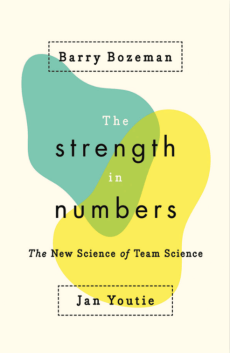
The Strength in Numbers: The New Science of Team Science
Barry Bozeman & Jan Youtie
248 pages, Princeton University Press, 2017
Science has never been a solitary enterprise. Theoretical advances are not made; they emerge from within communities of scientists, and it is often difficult to pinpoint a single event of “discovery.” Even when theories come together in the hands of particular scientists, assigning credit is an exercise rife with intrigue. Some of history’s most momentous scientific breakthroughs are no exception: Charles Darwin and Alfred Russel Wallace came up with theories of evolution concurrently; the dispute continues over whether Isaac Newton or Gottfried Wilhelm Leibniz invented calculus.
Yet, it is clear that practicing science in the 21st century requires an unprecedented level of teamwork, to meet the demands for specialized skills posed by modern scientific and social problems. The Strength in Numbers is an attempt to understand—and, indeed, harness for social good—what the authors term a “revolution” characterized by “the growth in the sheer number of collaborators, but also … a greater mix in the number and disciplinary diversity of collaborators.”
Part anthropology of scientific teams, part sociology of scientific collaboration, and part self-help for practicing scientists, the book may seem too ambitious and simultaneously not ambitious enough to some readers. The authors surveyed more than 600 scientists (mostly tenured professors) from 108 US universities across various disciplines about their experiences with collaborative research. They suggest an “aggregate model” for evaluating a research collaboration’s effectiveness, which they use to build multifaceted assessments of scientific teams from their survey data. The process involves assessing factors such as the ability to work through differences in practice across fields, chemistry among team members, and the team leader’s or leaders’ management ability. On this last factor, the authors recommend that project leaders consult all collaborators at all key points in the research to ensure collective buy-in—a practice they call “Consultative Collaboration Management.”
The book succeeds on several counts. The diversity of scientific disciplines that the survey encompasses is remarkable, especially given the amount of effort required to organize the subjective experiences of researchers across disciplines, each with its own norms for such things as attribution, authorship, and publication. The study’s disciplinary diversity stands in contrast with much of the previous research on scientific collaboration, which has focused on the biosciences.
Also commendable is the authors’ determination to maintain a subjective tone in presenting their findings. “It is our subjects’ words that provide most of the knowledge presented here,” they write. This qualitative approach is especially welcome: Scientific academia relies excessively on easily quantified outputs such as coauthorship and citation counts as metrics of productivity. In our view, these metrics may not only be misleading but also drive the vicious publish-or-perish cycle that lies at the heart of perverse incentives in the practice of science.
It is unfortunate, then, that the authors devote much of the rest of the book to discussing authorship and suggesting remedies for teams experiencing disagreements over research credit. The preoccupation with citations and authorship somewhat undermines the book’s objective of providing a more holistic view of modern scientific collaborations that can contribute to social good. Moreover, in emphasizing the novelty of its approach, the book fails to place the authors’ findings in the context of pre-existing literature. This includes decades of work in operations research and management science around concepts such as transaction costs and exchange theory, which could help illuminate team members’ potential psychological barriers to collaboration and draw more concrete lessons from the authors’ findings for researchers and leaders outside of scientific academia.
Underlying the book’s sentiment is the commendable ideal that scientific research ought to be a collective endeavor for the benefit of more than just the individual scientists’ careers. “Research effectiveness is not best viewed in terms of personal gain,” they write. But they do not fully explore what, if anything, can be done at a systemic or policy level to motivate scientists to pursue broader social goals. How should we restructure the scientific establishment for a collaboration-driven future? The book treats the fault lines encountered in the course of scientific collaborations almost as givens, rather than social constructs over which we might have some control. In this context at least, the authors’ entreaties for more effective communication in scientific teams risk ringing hollow, as the Consultative Collaboration Management approach appears to treat only the symptoms of the disease rather than the cause. The reader is left wondering what could be done to address institutional barriers that may prevent collaboration in the first place—such as hiring practices based on publication metrics.
Lacking a concrete call to action, The Strength in Numbers feels like a missed opportunity. A range of policy changes could improve scientific practice, both for scientists and for society at large. These include providing extensive management training to graduate students early on in their academic careers, establishing permanent senior scientist positions at universities for postdoctoral scholars who prefer not to manage lab groups and bring in grants, and restructuring assessment mechanisms of scientific work to de-emphasize hollow metrics such as a scientist’s number of publications and citations. We remain convinced that the scientific community is ultimately capable of holding itself to a higher standard. This book about a revolution in 21st-century science could do with a little more revolutionary thinking.

